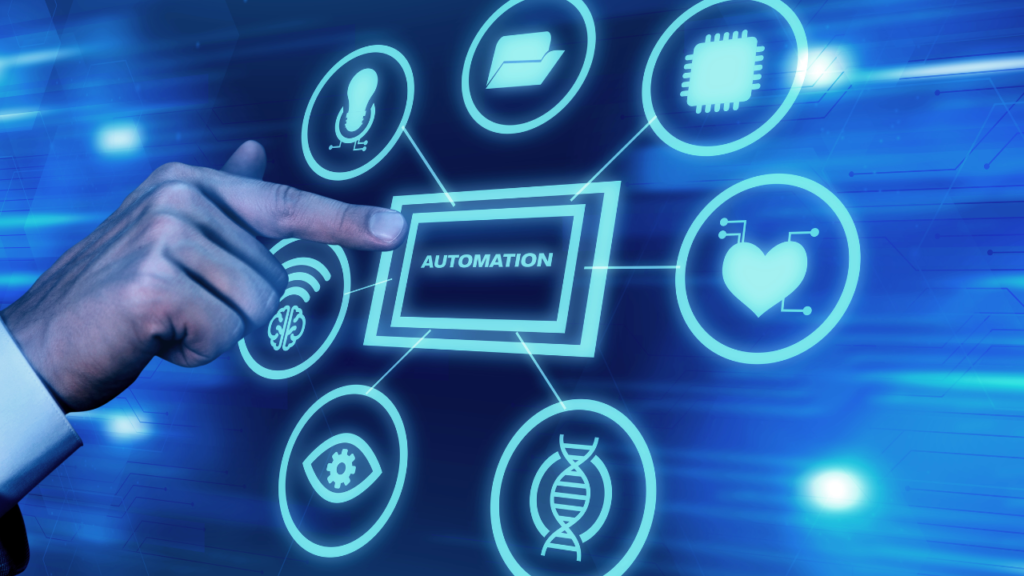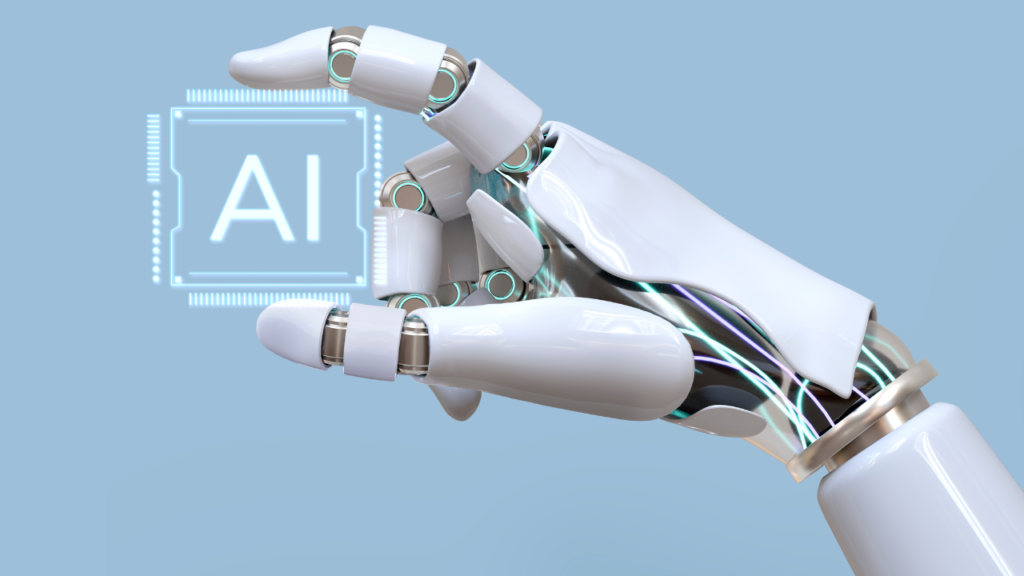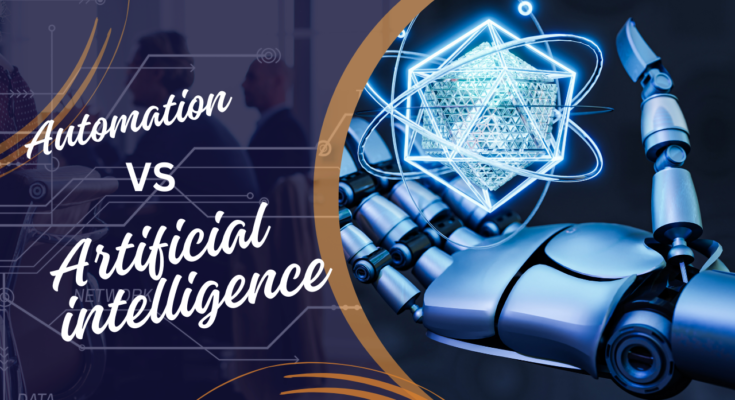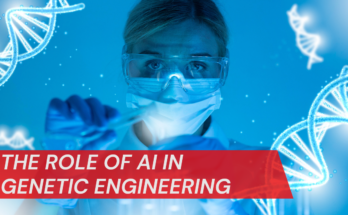Automation and Artificial intelligence : What’s the Difference Between?
Automation and artificial intelligence (AI) become a widespread technology. Although distinct, these technologies have the potential to significantly transform corporate processes. To successfully incorporate both into their operations, businesses need to understand the differences between automation and artificial intelligence.
Automation:
Automation is the application of technology to carry out operations that were previously handled by an individual or group of individuals. Simple rule-based software that automates monotonous operations and sophisticated systems that can manage particular business processes within a workflow more quickly and precisely than a person can both be classified as automation process software. For example, automation software works well with data entry and form filling.
Software that can be designed to carry out repeated operations like the ones listed above is used in RPA. Processes in a variety of areas, including as finance, human resources, and customer support, may be automated with RPA.

RPA is a supplemental automation solution that operates on top of current IT systems; yet, because it is a legacy “rules-based” automation technology, it has a reputation for being difficult to maintain and “fragile.”
While RPA has its uses, updating it in a big organization with often changing processes may be challenging. Watch this demo video to observe where traditional technology fails and to learn more about RPA.
“Intelligent” automation is another novel form of automation that combines RPA and artificial intelligence (AI) with other technologies for software automation. Historically, RPA and artificial intelligence have been employed in intelligent automation to automate some challenging tasks with little to no human intervention.
Nevertheless, Intelligent Automation overpromised and underdelivered actual value after briefly enjoying a brief “hype,” which resulted in more disappointment than success. This is due to the fact that legacy RPA suppliers employ an AI created by a different vendor to automate simple, repetitive screen operations in orchestration; this results in an ineffective AI “bandaid” being applied to an existing “brittle” RPA solution.
Automated applications
Numerous sectors and enterprises have found extensive uses for automation.
manufacturing:
financial sector:
logistics and supply chain management:
Order management, inventory tracking, and shipping route optimization are just a few of the supply chain operations that may be done more precisely and effectively with the help of automation in supply chain management and logistics.
The way automation technology develops further will influence how we think about workflows, procedures, and workplace productivity. It is essential to understand how to use automation in your own organization.
Artificial intelligence
In simple terms, artificial intelligence (AI) is the software counterpart of human intelligence. Artificial Intelligence (AI) is the development of algorithms that can do challenging, complex, and unique tasks that often need human intelligence. Artificial intelligence has the capacity to reason, acquire knowledge, resolve issues, and even make judgments under some conditions.

Some subfields of machine learning (AI) include computer vision, machine learning (ML), and natural language processing (NLP). These fields implement algorithms to find patterns in data and estimate future events. Computers can understand text or audio input and provide spontaneous replies by using natural language processing. Computer vision is the study and use of computers’ ability to perceive and analyze visual data, such as objects in pictures or movies.
AI applications
Artificial Intelligence is starting to appear in almost every field and sector. Modern developments have render artificial intelligence crucial for industries like manufacturing and banking.
finance and manufacturing:
In order to prevent fraud and improve institutional security, artificial intelligence is being used in banking more and more. AI-powered computers continuously sift through enormous amounts of financial data, looking for odd patterns or groupings of behavior in an attempt to predict stock prices and identify potential investment possibilities. Transaction data may be analyzed by AI to spot unusual activity and stop fraud. Furthermore, for financial services teams and organizations wishing to apply AI, invoice processing and check identification are important use cases.
retail sector:
The retail sector uses artificial intelligence (AI) to improve supply chain management and offer personalized shopping experiences. It enables communications, product recommendations, and innovations that correspond to a customer’s previous purchases. Through demand forecasting and inventory optimization based on historical data, AI also improves logistics and inventory management.
AI may also be used to automate client requests and classify incoming emails based on purpose by integrating it with email servers or customer relationship management (CRM) software.
Machine learning and deep learning are popular AI techniques.
Differences between automation and artificial intelligence
The key differences between Automation and Artificial intelligence lie in their capabilities and limitations:
| Feature | Artificial Intelligence (AI) | Automation |
|---|---|---|
| Definition |
Artificial intelligence (AI) is the study of creating computer systems that can carry out operations that normally require human intellect, such as recognizing words, recognizing images, language translation, and decision-making processes. |
Automation is the process of doing tasks without requiring human contact by using machines and technology. Improving speed, preciseness, and efficacy in habitual or repeated tasks is its aim. |
| Learning ability | AI systems have the capacity to grow in performance over time by learning from data and adapting to new knowledge. Machine learning and deep learning are popular AI techniques. |
Automation usually adheres to preprogrammed instructions; it is not capable of self-adaptation or self-learning. When doing tasks, it complies with a predefined set of rules. |
| Flexibility |
Automation typically follows preprogrammed instructions; it cannot be capable of evolving or self-learning. When doing tasks, it adheres to a predefined set of rules. |
While automation is often developed for certain, repetitive activities, its ability to perform jobs outside of its set scope without retraining may be limited. |
| Decision-making | AI systems are capable of making judgments through pattern recognition and data analysis. They could even be capable of showing some degree of intelligence and the capacity to make complicated judgments. |
Generally speaking, automation is programmed to do specific tasks and cannot make decisions outside of those parameters. |
| Examples |
Automated cars, chatbots, recommendation engines, image recognition, and natural language processing. |
Automated assembly lines, email responses, industrial robots, and programmable thermostats. |
| Human interaction |
Natural language processing, comprehension and production of human-like responses, and user interaction learning are some of the ways AI systems can communicate with people. |
In order to complete tasks without requiring constant human input, automation may involve little to no direct human interaction. |
| Adaptability |
Because machine learning (AI) systems can adapt to changing tasks, environments, and data patterns, they are ideal for scenarios that are dynamic and constantly evolving. |
Automation could not be as flexible as it might be and can require reconfiguration or reprogramming as activities or processes change. |
| Complexity |
Due to the use of complex computations, enormous amounts of data, and potent computers, artificial intelligence (AI) systems are generally more complicated. |
Systems for automation could be more straightforward, requiring only simple programming to carry out predetermined tasks effectively. |
| Problem-solving |
AI systems exhibit problem-solving skills by analyzing data, identifying trends, and making informed judgments. |
In contrast, automation is primarily focused on task execution and may lack the ability to address problems beyond its predefined scope. |
Automation and Artificial intelligence intersection:
Although separate, automation and artificial intelligence frequently come together. AI’s machine learning subset is capable of improving and streamlining automated procedures. To increase the effectiveness of automated production lines, Automation and Artificial intelligence may be used to evaluate sensor data in factories to forecast equipment breakdowns and start predictive maintenance.

Future of Automation and Artificial intelligence:
Automation and Artificial intelligence will both continue to have a significant impact on how our future is shaped. While artificial intelligence (AI) will handle complicated decision-making and spur innovation, automation will continue to be the workhorse for repetitive activities. Comprehending Automation and Artificial intelligence distinctions is crucial for both individuals and businesses to effectively use automation and artificial intelligence unique capabilities and maneuver through the dynamic terrain of technology.
Conclusion:
Automation and Artificial intelligence, sometimes confused for identical twins, are actually more like opposing forces in an innovative symphony. Automation is the meticulous artisan that specializes at repetition and perfection, simplifying industries and our daily lives. Artificial Intelligence (AI) is a visionary maestro that pushes the limits of machine intelligence, learning, producing, and adapting to take humanity to new heights. The future will be defined by their peaceful interaction. Efficiency will always be based on automation, which works nonstop to complete tasks that have been predetermined.

